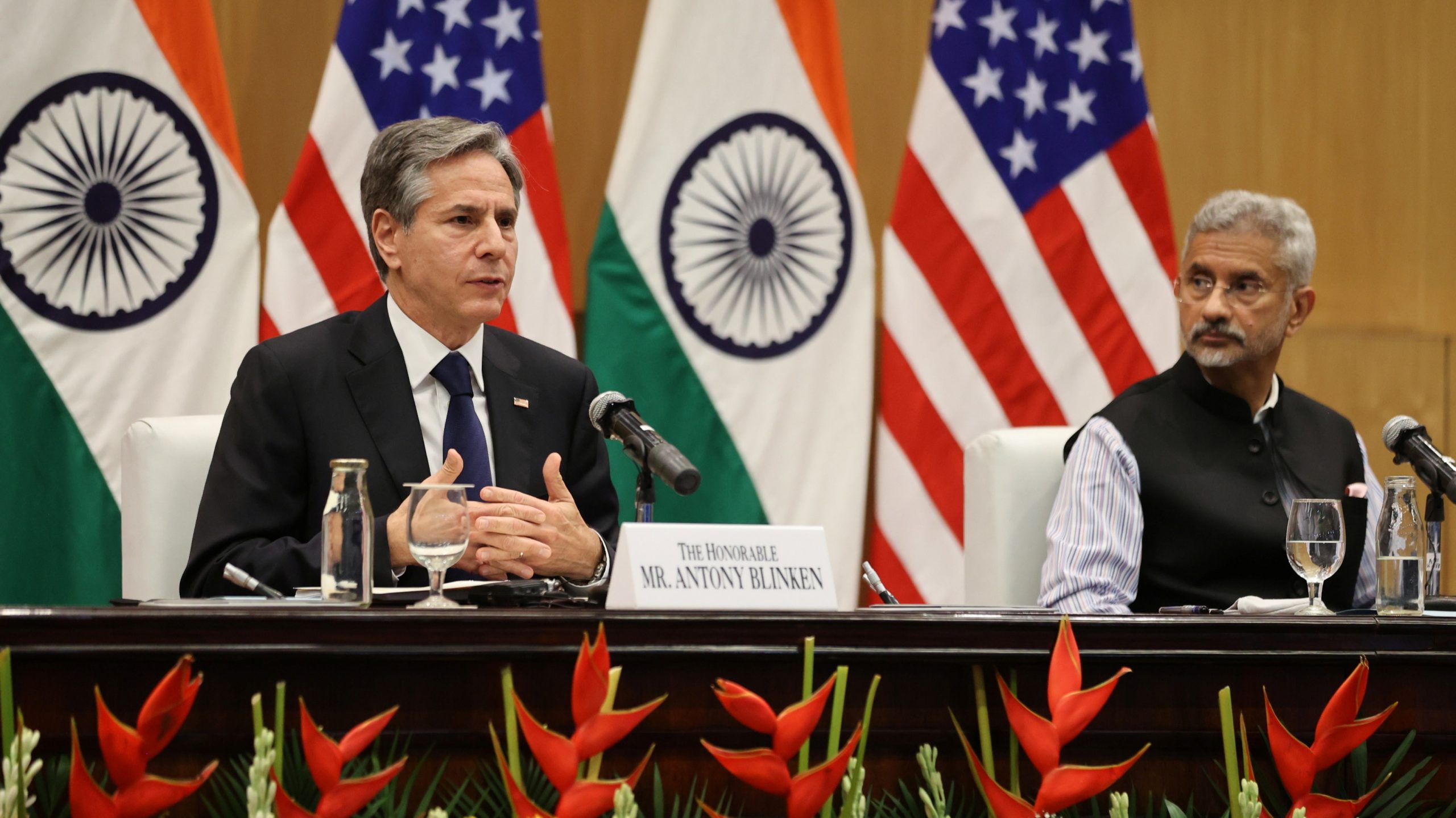Abhay Kumar Singh
On 7 July 2023, the US Department of Defense (DoD) announced additional security assistance to meet Ukraine’s critical security and defence needs. In addition, the package will provide Ukraine with additional artillery systems and ammunition, including the highly effective and reliable dual-purpose improved conventional munitions (DPICM), a type of cluster munition.
This decision to transfer DPICM to Ukraine has become controversial as more than 100 countries have outlawed this type of munitions under the Convention on Cluster Munitions (CCM). The US, Ukraine and Russia are not signatories to CCM.
The US DoD claimed that the decision to transfer DPICM was arrived at after extensive consultations with the US Congress and US allies and partners. In an interview with CNN, President Joe Biden said that his decision to provide Ukraine with cluster munitions was a “difficult decision”.
Cluster munitions can, in general terms, be defined as “weapons that open in mid-air and disperse smaller sub-munitions—anything from a few dozen to hundreds—into an area. They can be delivered by aircraft or from ground systems, such as artillery, rockets and missiles”. They contain sub-munitions or bomblets with impact fuses designed to detonate on impact with the ground or hard surface. They could also be fused to create an air burst at a prescribed height from the ground. A typical Cluster munition ordnance, depending on its design, can release explosive sub-munition ranging from several dozen to over 600.
Cluster munitions have emerged as weapons of choice for militaries due to their ability to create destructive effects over an area much larger than the one created by the effects of equivalent munitions with singular warheads. The criteria of ‘economy of force’ is accomplished through the use of cluster munition since one munition can be used to suppress, kill or destroy multiple targets within its impact area. Employment of such area weapons needs fewer platforms (aircraft, artillery tubes, etc.) delivering fewer munitions for desired effects which reduces the logistics burden and the exposure of forces to hostile fire. Similarly, cluster munitions allow a numerically smaller force to engage and degrade a larger adversary.
Cluster munitions were deployed extensively in the Vietnam War. During that conflict, the US dropped some 260 million of them on neighboring Laos, making it the country with the world’s highest level of cluster munition contamination. The US Army also used the ‘Steel rain’ of DPICM to break Iraqi’s soldier’s will to fight both during the Gulf War of 1991 and the invasion of Iraq in 2003.
DPICM is a general category of ordnance with the US Army and includes various types of artillery shells and rockets loaded with a variety of sub-munitions. It includes shells for 105mm, 155mm, and 203mm howitzers, as well as 227mm artillery rockets that can be fired from the M270 Multiple Launch Rocket System (MLRS) and M142 High Mobility Artillery Rocket System (HIMARS) launchers.

DPICM is an evolved version of the Improved Conventional Munition (ICM) series of cluster munitions. ‘Dual-purpose’ denotes the fact that the DPICM sub-munitions, also referred to as ‘grenades’, are designed to be effective against both armored vehicles, as well as soft-skin unarmored vehicles and troops.
As a result of extensive Russian fortifications, particularly minefields and extensive trench lines, Ukraine’s counteroffensive has so far been difficult to get rolling. When classical artillery fires round with unitary warheads, for example, trenches may withstand this type of indirect fire very well. Even less effective is direct fire, such as that from cannons and tank guns. To saturate them from above, it may require a sizable number of unitary high-explosive artillery rounds launched indirectly. Even then, they may not be as effective against well-entrenched forces.
According to sources, Ukraine’s employment of artillery has had to be reduced or limited as a result of munitions shortages. There are reports that Ukraine has been compelled to cut or limit the use of artillery because it has shortages of munitions. The resultant ‘artillery’ or ‘ammunition’ diet has been attributed as a critical factor hindering the progress of the Ukrainian counter-offensive. Ukraine’s forces need to create gaps in the Russian defence line to push through with armored formations.
The fundamental criticisms of cluster munitions are that they disperse large numbers of sub-munitions imprecisely over an extended area, that they frequently fail to detonate and are difficult to detect, and that sub-munitions can remain explosive hazards for decades. Cluster munitions’ bomblets are generally designed to explode or ignite upon hitting the ground, but historically their failure rate is the highest among all classes of weapons, with lasting and often devastating consequences for civilians. Civilian casualties are primarily caused by munitions being fired into areas where soldiers and civilians are intermixed, inaccurate cluster munitions landing in populated areas, or civilians traversing areas where cluster munitions have been employed but failed to explode.
Two technical characteristics of submunitions—failure rate and lack of a self-destruct capability—have been at the core of the criticism of cluster munition. There exist significant discrepancies among failure rate estimates. While a few manufacturers claim a submunition failure rate of 2 to 5 per cent, field reports have recorded failure rates of 10 to 30 per cent. Several factors influence submunition reliability. In addition, factors impacting higher failure rates of submunition include delivery technique, age of the submunition, air temperature, landing in soft or muddy ground, getting caught in trees and vegetation, and submunition being damaged after dispersal, or landing in such a manner that their impact fuses fail to initiate. In addition, submunitions without a self-destruct capability are of specific concern since they can remain an unexploded ordnance (UXO) hazard for decades, thereby increasing the potential for civilian casualties.
In order to address humanitarian concerns about UXO, some nations are developing ‘smart’ or sensor-fuzed weapons with greater reliability and a variety of self-destruct mechanisms intended to address the residual hazard of submunitions. The US has argued that DPICM shells being sent to Ukraine are an improved version of ammunition and has an estimated failure rate of 2.35 per cent or less, far better than the usual rate that is common for cluster weapons. However, the cluster munitions in question contain older grenades which as per the US DoD’s study are known to have a failure rate of 14 per cent or more.
All weapons carry a certain amount of risk, but cluster bombs have been said to represent a special danger to people since they routinely leave behind a lot of unexploded bomblets and have a huge area of effect. These unexploded bomblets can continue to pose a threat for decades after combat has ended.
Described as “frustrated with the CCW process”, several CCW members—led by Norway, initiated negotiations in 2007 outside of the CCW to ban cluster munitions. On 30 May 2008, they reached an agreement, Convention on Cluster Munitions (CCM), to ban cluster munitions. The US, Russia, China, Israel, Egypt, India, and Pakistan did not participate in the talks or sign the agreement. On 3–4 December 2008, 94 states signed the convention in Oslo, and four of those signatories also ratified it at the same time. France, Germany, and the United Kingdom were among the 18 NATO members who are signatories of the CCM. Six months following the deposit of the thirty-first ratification, the convention was supposed to go into effect. On 16 February 2010, the UN received the 30th ratification, and the agreement became effective on 1 August 2010.24
The CCM, inter alia, bans the use of cluster munitions, as well as their development, production, acquisition, transfer, and stockpiling. The convention exempts ‘Smart Cluster Munitions’ that can detect and engage a single target or explosive sub-munitions equipped with an electronic self-destruction or self-deactivating feature.
Conclusion
DPICM availability will not only improve Ukrainian military performance against Russian forces that are entrenched, but it will also aid in reducing Ukrainian and wider NATO ammunition shortages and barrel shortages. Even before the extant controversy about DPICM, cluster munitions have been employed during the ongoing Ukraine war by both belligerents. Since the invasion of Ukraine on 24 February 2022, the Russian military has been reported to have extensively employed at least six types of cluster munitions: missiles for multiple rocket launchers ‘Hurricane’, ‘Smerch’, ‘Tornado-S’, missile systems ‘Tochka’ and ‘Iskander-M’, as well as RBC bombs (500 with PTAB-1M submunitions). Ukrainian forces were also noted to have used Soviet-origin cluster munition at least three times in the war.
Notwithstanding provisions of CCM and rather widespread humanitarian concern, cluster munitions remain a legitimate weapon of war. Legal prohibition of production, stockpiling, transfer and use remains applicable only to signatories of the conventions even though members of CCM such as the Cluster Munition Coalition (CMC) continue to campaign for the widespread accession to and ratification of the CCM.
In any case, CCM provisions are not relevant in the extant case of DPICM supply to Ukraine. The Convention has never been ratified by the US, Ukraine, or Russia. Additionally, the treaty was never ratified by Poland and Romania, two NATO members through whom weapons would presumably pass to reach Ukraine. Therefore, in the context of the Ukraine war, parties involved in the supply, transit or future use of these weapons are not constrained by any specific legal prohibition against their use, including restrictions imposed under provisions of CCM.
Cmde Abhay Kumar Singh (Retd) is Research Fellow at the Manohar Parrikar Institute for Defence Studies and Analyses, New Delhi.
Views expressed are of the author and do not necessarily reflect the views of the Manohar Parrikar IDSA or of the Government of India.
The full version of this article first appeared in the Comments section of the website (www.idsa.in) of Manohar Parrikar Institute for Defense Studies and Analyses, New Delhi on July 20, 2023


























